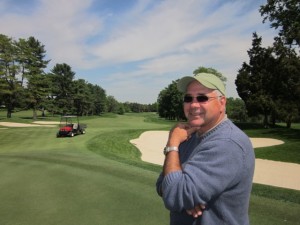Born and raised in Traverse City, MI, Congressional Country Club’s Director of Golf Course Maintenance Mike Giuffre (pronounced JOO-free) has always enjoyed working outdoors. Some of his fondest childhood memories include picking and harvesting cherries with his parents and grandparents. “Being outdoors, especially in northern Michigan, was always special to me,” says Giuffre, 50, a longstanding member of the Golf Course Superintendents Association of America and whose resume includes stops as the Superintendent at The Bear in Traverse City and later at TPC of Michigan in Dearborn.
In all, Giuffre has overseen the maintenance operations for six different Tour events spanning 13 years for such tournaments as the B.C. Open, the Kemper Open, the Booz Allen Classic, and the A T & T National. At Congressional for the past 12 years, he also prepared the club’s Blue Course (site of this year’s U.S. Open) for the 2009 U.S. Amateur. In May, Giuffre gave me a personal tour of the Blue course (there’s also a Gold Course), sharing insights on its renovation and preparation for its third U.S. Open and its first since 1997 when Ernie Els won. Understated and self-effacing, Giuffre was quick to credit Congressional’s impeccable conditions to its membership (3,000 in all!) and to his staff. He’s the sort of person who recalls golf course architect Rees Jones’ apt line about another hard-working, unpretentious and no-nonsense superintendent: “He’s all solutions and no excuses.” After spending almost two hours with Giuffre on a sunny Friday morning and yes, being outdoors, I didn’t know what or who impressed me more: Congressional or its superintendent. –Terry Moore
Q: What’s been the result?
A: The greens now have a more uniformed growing pattern which means smoother putts. The hybrid bent grass used is a deep-rooted grass that does well in this area. But we’re not only excited about the grass but also how the greens were rebuilt with sand according to USGA specifications. The new greens will allow for more firmness in them not only for the Open championship but also for day-to-day member play.
Q: Speaking of this region, it can be problematic in terms of weather, right?
A: Yes, the micro-climate in the D.C. areas can be challenging. We can have 5-6 inches of rainfall in a single front. In 2006 for a British Open qualifier here, the course was deluged with 13 inches of rain in just three days. But now due to the renovation we have sub-air vacuums in all of the greens so we can better deal with the moisture. And last summer with its terrible heat wave we had to close the course for 13 days. In such heat, you have to be careful with young greens that you don’t walk the grass off them.
Q: Is it the topography of the region that plays a part too?
A: Yes, there are mountains to the west and the ocean to the east. It can lead to big pockets of high humidity trapped in this area. It’s a difficult area to grow grass well.
Q: From the players’ standpoint, talk about the other changes made to the course with the 2006 re-design efforts of Rees Jones.
A: The field will see a longer course and one with more offset tees and more shaped fairways than ever before. It will be demanding but these pros are so talented that the cream will still rise to the top. Rees Jones has done a wonderful job of instilling more thought and strategy into a player’s tee shots—especially on the front side. And he’s so great to work with. Also, we had a great contractor—McDonald & Sons–a local construction company that has worked on a number of Open courses. They did a fantastic job for us.
Q: Talk about what your staff has done getting the bunkers ready for the Open.
A: We added new sand to the greenside bunkers last summer while the sand in the fairways bunkers was done this past winter. The USGA has a different perspective with bunkers than the PGA Tour. Bunkers are meant to be bunkers and it’s willing to accept that a player may incur a buried and less than ideal lie in the bunker. The USGA doesn’t want them to be unfair, having the ball always bury. But it allows for the possibility of the ball nestling down in the bunker and not lending a perfect lie.
Q: How is that different than the Tour’s stance on bunkers?
A: It’s a different mindset. The Tour wants the bunkers to be firm, avoiding buried or poor lies at all times. So we would spend an inordinate amount of hours on bunkers for a Tour event—tamping them down, firming them up and with lots of watering. I can’t even estimate the time we used to spend on bunkers at the TPC of Michigan for the Senior Players Championship. But I do see the Tour moving in the direction of the USGA when it comes to bunkers.
Q: And the overall course set-up by USGA’s Mike Davis?
A: It will be tough but fair. As in recent Opens, Mike wants a graduated rough that gets longer the farther one is off the fairway. But on the shorter par-fours there will be slightly longer rough just off the fairway because the players will be using more lofted clubs to recover or get to the green. But Mike doesn’t want the rough so penal that there’s no chance at all to reach the green from it.
Watch this short video of Mike Giuffre talking about the new greens at Congressional’s Blue Course: http://www.youtube.com/watch?v=efAbTmJo0sc

